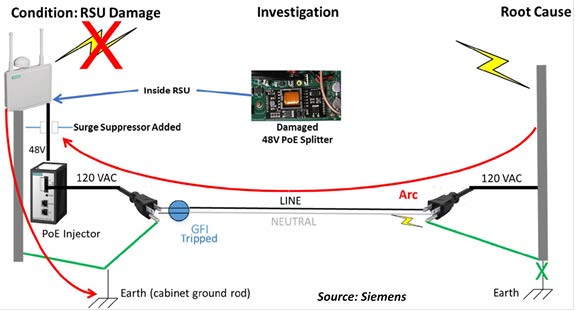Success Stories from the USDOT’s Connected Vehicle Pilot Program.
Tampa, Florida, United States
Connected Vehicle Deployment Technical Assistance: Roadside Unit (RSU) Lessons Learned and Best Practices
Summary Information
In September of 2015, USDOT selected New York City Department of Transportation (NYCDOT), Wyoming Department of Transportation (WYDOT) and Tampa Hillsborough Expressway Authority (THEA) as the recipients of a combined $42 million in federal funding to pilot next-generation infrastructure and vehicle technology under the Connected Vehicle Pilot Deployment Program.
One of the program goals is to resolve technical deployment issues. During one year of continuous testing, the THEA Pilot found that four of the forty-four installed roadside units (RSUs) were not communicating with the Master server. After a series of investigations, THEA concluded that some RSUs were not grounded properly and that lightning strikes were causing damage to the RSUs. The THEA Pilot resolved the issues after replacing the RSUs and properly grounding them. The following paragraphs detail the investigation process performed by the THEA Pilot’s RSU vendor.
The first set of THEA’s RSUs was installed prior to November 2017. Following roughly a year of operation, four RSUs were found to not be broadcasting messages and were reported as "Configured in Master Server, but not communicating with RSU". The RSUs were disassembled and each electronic assembly was tested. The Power over Ethernet (PoE) Splitter, an electrical subassembly that splits the Ethernet transmit data pair (TX+, TX-) and receive data pair (RX+, RX-) from 48 VDC that powers the RSU, was found to be damaged by electrical surge. This damage may leave the RSU powered but not communicating which matches the indication at the Master Server.
The PoE Splitter was examined and found to be damaged by exposure to excessive voltage entering the Ethernet connection from the PoE Injector located inside the roadside electrical cabinet. Because no similar symptoms were reported from installations of identical equipment, local conditions in Tampa were investigated next. Each RSU was found to be installed and bonded to the mast arms correctly according to the vendor installation instructions. Lightning damage from direct hits to antennas or to the RSU itself was ruled out, as no damage to any electronic subassemblies attached to exposed antennas was observed. Next, the metal structures supporting the RSUs as well as nearby metal structures, such as poles, were examined. Some were found to be bonded to the ground, while some were not. Based on the analysis, the investigation concluded the root cause to be lightning strikes to ungrounded metal structures where the arc introduces a voltage surge entering the RSU at the Ethernet connector. The Ethernet connector is attached directly to the PoE Splitter electronic subassembly mounted inside the RSU. When damaged, the PoE Splitter ceases communications to the Master Server, which initially reported that condition. Upon realizing this, THEA replaced the PoE splitter for all four RSUs – resulting in the RSUs returning to normal functionality again.
The figure below graphically depicts the issue. Cloud-to-ground lightning strikes seek the path of least resistance (i.e., the ground connection on each structure). When grounded (no green "X"), the strike is contained. When left ungrounded as shown by the green "X", the next least path of resistance to earth ground is through 120VAC servicing the PoE Injector, continuing through the PoE Splitter of the RSU while seeking the ground of the RSU. That path of least resistance from the ungrounded structure through the RSU is shown as the two red arrows of the figure, likely an air-gap arc shown.

